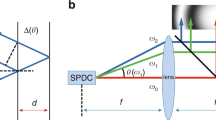Summary
The superposition of two coherent beams in different states of elliptic polarisation is discussed in a general manner. If A and B represent the states of polarisation of the given beams on the Poincaré sphere, and C that of the resultant beam, the result is simply expressed in terms of the sides,a, b, c of the spherical triangle ABC. The intensity I of the resultant beam is given by:
the extent of mutual interference thus varies from a maximum for identically polarised beams (c = 0), to zero for oppositely polarised beams (c = π). The state of polarisation C of the resultant beam is located by sin2 1/2a = (I1/I) sin2 1/2c and sin2 1/2b = (I2/I) sin2 1/2c. The ‘phase difference’ δ is equal to the supplement of half the area of the triangle C′BA (where C′ is the point diametrically opposite to C). These results also apply to the converse problem of the decomposition of a polarised beam into two others.
The interference of two coherent beams after resolution into the same state of elliptic polarisation by an elliptic analyser or compensator is discussed; as also the interference (direct,and after resolution by an analyser) ofn coherent pencils in different states of polarisation.
Similar content being viewed by others
References
Chandrasekhar, S.Radiative Transfer, Oxford, 1949.
Fano, U.J. Opt. Soc. Am., 1949,39, 859.
Jerrard, H. G. —, 1954,44, 634.
Mascart, E.Traite d’Optique, Paris, 1891,2.
M’Clelland, W. J. and Preston, T.A Treatise on Spherical Trigonometry with Applications to Spherical Geometry, 1897, PartsI andII, Macmillan.
Pancharatnam, S.Proc. Ind. Acad. Sci., 1955,42 A, 235.
Perrin, F.J. Chem. Phys., 1942,10, 415.
Pockels, F.Lehrbuch der Kristalloptik, Teubner, 1906.
Ramachandran, G. N. and Ramaseshan, S.J. Opt. Soc. Am., 1952,42, 49.
Ramachandran, G. N.J. Madras Univ., 1952,22 B, 277.
RayleighScientific Papers, Cambridge, 1902,3, 140.
Stokes, G. G.Mathematical and Physical Papers, Cambridge, 1901,3, 233.
Walker, J.Analytical Theory of Light, Cambridge, 1904.
Author information
Authors and Affiliations
Additional information
Communicated by Sir C. V. Raman
Rights and permissions
About this article
Cite this article
Pancharatnam, S. Generalized theory of interference, and its applications. Proc. Indian Acad. Sci. 44, 247–262 (1956). https://doi.org/10.1007/BF03046050
Received:
Issue Date:
DOI: https://doi.org/10.1007/BF03046050




